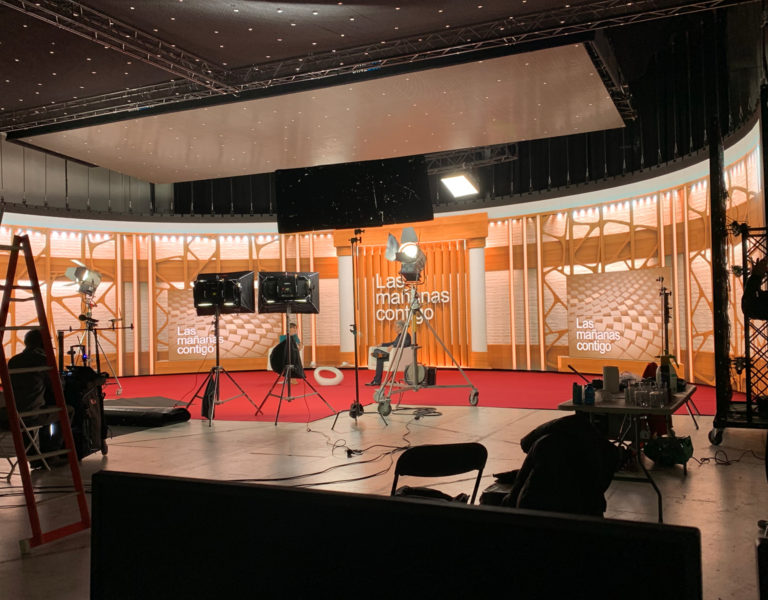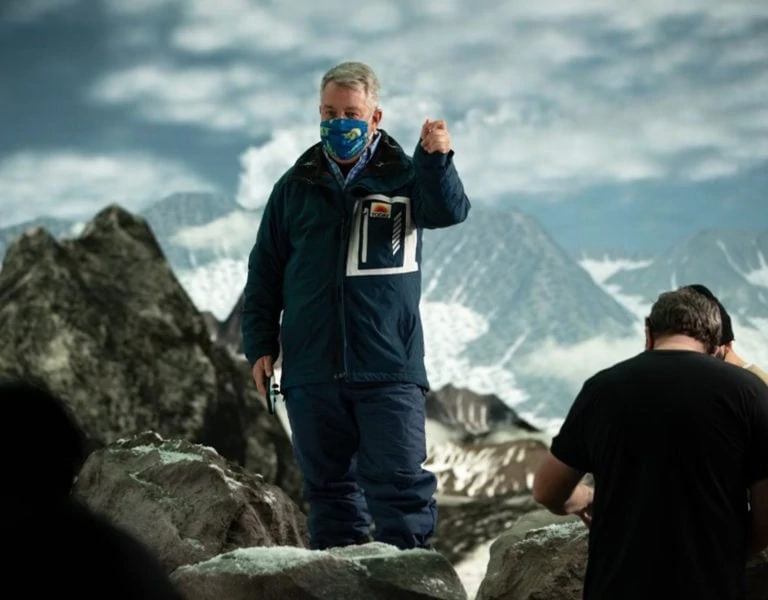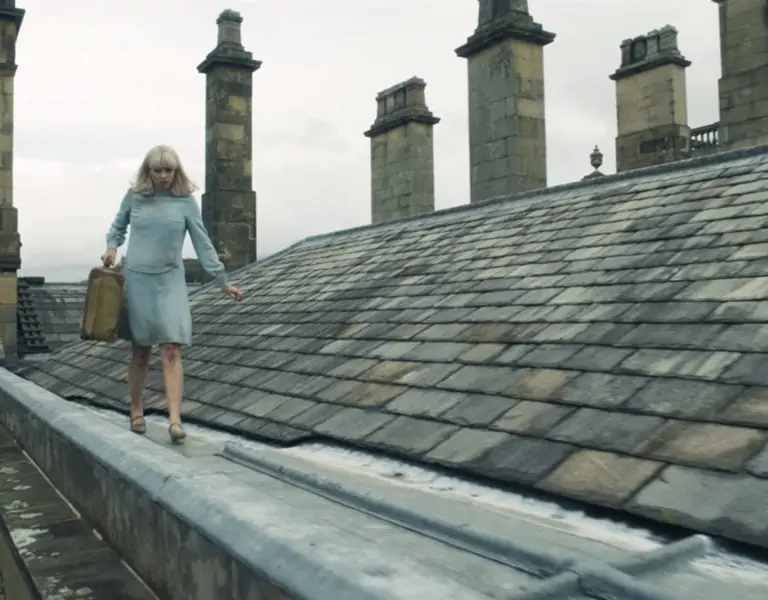Risky business
Cinematographer Nikita Kuzmenko reunites with film school collaborator Dmytro Sukholytkyy-Sobchuk after a decade to lens eerie folk thriller Pamfir.
Deep in the Carpathians, we meet the eponymous Pamfir (Oleksandr Yatsentyuk), who has just returned home to Ukraine to celebrate the Malanka Festival with his family. However, after his son’s misguided attempt to stop his father from leaving again, Pamfir becomes embroiled in trouble once more.
It marks a sizzling long-form debut and a wonderful tribute to Ukraine’s filmmaking culture in these troubled times from director Ukrainian Dmytro Sukholytkyy-Sobchuk, with ethereal visuals crafted by his fellow countryman Nikita Kuzmenko. The DP, who has shot music videos for the likes of Harry Styles and The Weeknd, shares his insight into using colour for storytelling and the challenges of shooting in remote mountain locations.

What appealed to you about the script for Pamfir and what made it stand out from your other features?
Pamfir was perhaps the best script I have ever read and worked on. For me it is very important how I feel emotionally about the characters and the story during and after reading a script, and Pamfir’s story was so well written that I became deeply connected to the main protagonist and other characters because of how well the personalities and relationships were presented and the universe they exist in. Living Fire, a documentary I shot a couple of years ago in the same region, helped me to understand the main topic of Pamfir, the script and the characters involved.
Pamfir isn’t your first time working with director Dmytro Sukholytkyy-Sobchuk – in fact, you first collaborated a decade ago. What do you think makes your director/DP relationship so successful?
My first collaboration with Dmytro happened in film school. We did our bachelor’s degrees in film together. The roots of our working relationship came from quite tough student projects involving a lot of ambitious ideas and almost no funds to execute them, but we both believed we could find a way to make the film. And in the end we did it, but facing a lots of challenges.
Looking back now, I think those projects gave us an opportunity to really meet each other as a humans, as artists and collaborators. I think we left film school with only love and respect for each other, which helped us to quickly reconnect again on Pamfir after a 10-year break. When I met Dmytro again after such a long break, I saw the same ambitious filmmaker with a lot of passion and love for his movie, which is also a very important aspect for me in filmmaking. It motivates me a lot when I see pure love between a director and his project.

Take us back to those early conversations with Dmytro about the look and mood for Pamfir. What was his vision, and what new ideas did you bring to the discussions?
Before I was invited to do the cinematography for Pamfir, Dmytro had a very long road in his project development; almost six years (in total) of scriptwriting, finding budget and casting. His visual concept was very clear in terms of colours, camera positioning and the overall mood of the film. He started location scouting two years before principal photography, and almost at the same time, together with our production designer Ivan Mikhailov, he started to develop the colour palette and concept art for the movie.
Together with the main actors, he spent three months living at the actual location and rehearsing all the scenes from the movie. An important part of the movie is the dialect of that region, which the actors learnt during the rehearsal period and studied with a dialect consultant.
Initially, his key visual idea was that each scene should be photographed in one shot: no cuts. He didn’t want to break the movement and the energy of the actors’ performance in each scene. The camera is always led by the main protagonist, with Pamfir leading the camera with his energy into the events he is facing. We should always be looking at Pamfir’s face on the same eye level and never at his back.
Colour-wise, Dmytro really wanted to give each colour we used a meaning. This was part of his visual rules that he brought to the table. All these elements gave us a very strong base for a visual language to discuss and to develop it at the next stage of production.
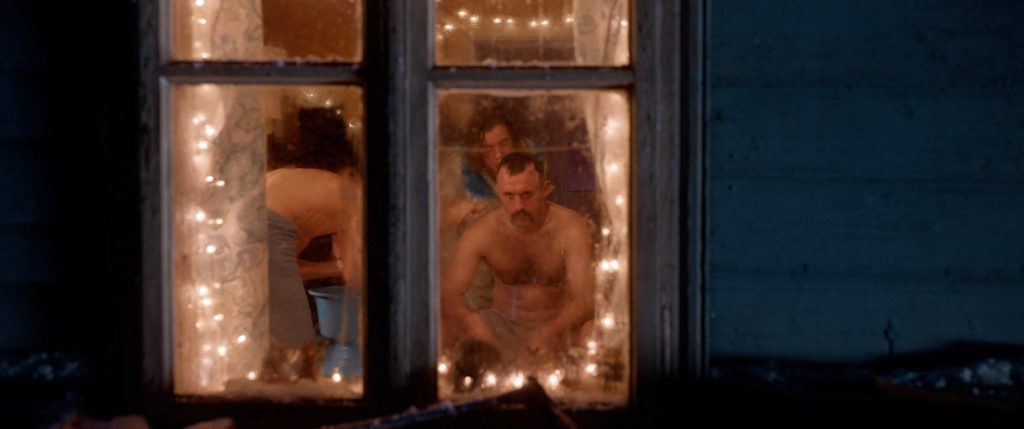
How long did prep last? What kind of research did you do, and what creative references did you and Dmytro exchange for the film’s visual language?
Unfortunately, I joined this project pretty late. Basically, all my prep lasted for only one month before principal photography. So, after I was confirmed for the production, we went straight to a tech recce with all the crew where we started to discover the reality which we were going to be facing.
We actually didn’t talk a lot about references. Both Dmytro and I didn’t like to work with reference images. The only images we discussed were related to contrast, colours, saturation and camera angles. I always try to be on the same page as my director and gaffer in this regard. Also at that stage, where we were in pre-production, there was no need to discuss any other images than our own.
During the intense recce process, which lasted for 12 days, we ran through each scene on an iPad, and recorded videos of the tracing shots. Directly afterwards, together with the gaffer Valeriy Butkov and Dmytro, we drew colours on the rehearsal video of potential light sources and colours that we imagine would be good for that scene and location.
After the recce, when we got back to Kyiv the next stage was to choose the right equipment for the project. Together with our production designer Ivan, we built a three-wall room with a window. We painted walls into our main colour palettes, we brought the main costumes and invited all the key actors. We shot those tests for the whole day – running different cameras, lenses, lighting, diffusions, compositions and portraits. This was very helpful for me and Dmytro to find technical solutions and keys to all our ideas that had only been ideas up until this point.
Our main visual/light contrast references were Caravaggio paintings, which we both really like. We had a deck of images with different frames from movies where we admired colours, compositions and contrast. That was a guide for us for the next few months of photography.
In terms of the mood, we discussed a couple of movies, but they were never a direct reference for Pamfir. A few films were a key inspiration for colour and how boldly colours can be used: Long Day’s Journey Into Night (2018), Black Coal, Thin Ice (2014) and In The Mood For Love (2000).
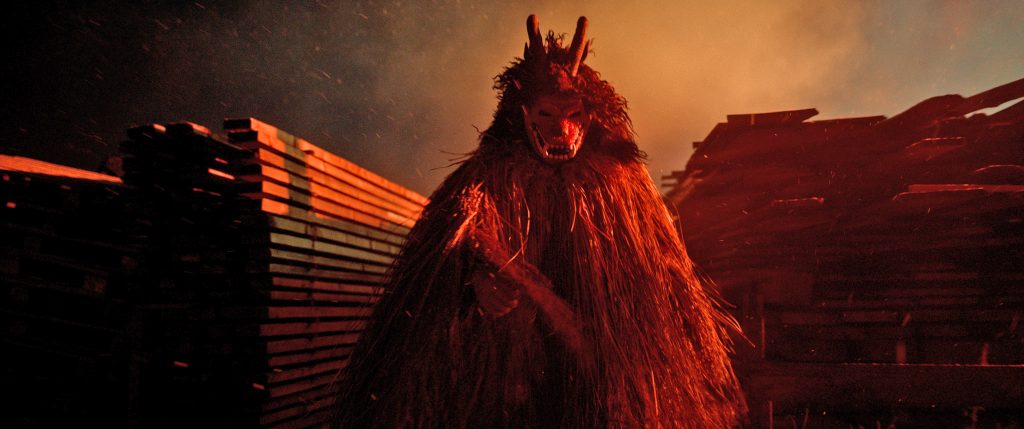
Can you run us through the film’s key locations? Were any sets built?
The movie includes about 25 locations in total. We shot in three different Ukrainian regions and 15 different small villages. All footage was shot in real locations, but most of them were completely redressed and recoloured. Only a few sets were built: a little wooden house that we see in the first scene of the movie, based on a new house outside of Pamfir’s house, and a bus station at the end of the film. But in terms of production design, Ivan and his team did an enormous job on each location.
I think it was very important to keep all locations real, because a very important part of this movie is the atmosphere and texture of the space. The locations we found and chose to shoot from were so authentic and unique that on screen you can definitely feel that those characters exist in the real world and yet unrecognisable. At one point, these film locations became an independent character in the movie, which tells us a lot about the universe of Pamfir!
An interesting fact: If you look closely, you can see that Pamfir’s house and his parents’ house are both super small with compact interiors, partly because they are super old, but sometimes you can see that the lines inside aren’t level.
A key scene is when Pamfir meets Morda – we enter a real forest where they have a room with a miniature forest and scarecrow with different forest animals. This room represents the main antagonist’s world and his character – a surreal place. This was also part of a real location that we found during our location scouting.
Of course, I need to mention the main location of the film – the forest, mountains and all the nature in this film. This was the most challenging part in terms of location shoots because sometimes we would shoot in the hidden gems of the Carpathian Mountains, where sometimes it would take us hours to get there. And none of the forest scenes locations are repeated; almost all scenes were shot in different forest landscapes.


When was principal photography and how long did it last for?
My pre-production started in September 2020 and principal photography started in mid-October 2020. We had 34 shooting days, but then we had a little break in the middle of January because we waited for the snow to come in the mountains.
An interesting fact is that the whole movie was shot from golden autumn to the deep winter. This was also part of the visual concept, to have this colour changing in the nature/forests and in the natural light as well. So we were aiming for that to help us tell the story of Pamfir.
What was your chosen camera and what made it especially suitable for Pamfir?
We shot Pamfir with the ARRI Alexa Mini LF.
I think it was very important for us to capture Pamfir’s story with that kind of sensor so we could fully transfer the audience to those places, so they can feel the textures, emotions and lights of Pamfir’s world. Large format was our first choice to be able to do that.
Because we had been very specific in our colour palette and the time of day we wanted to shoot (mostly blue hour), we needed a sensor that we could rely on in every situation for a two-month shoot deep in the mountains – the Mini LF was exactly that camera. And, of course, because our main tools were gimbals, the Mini LF was all perfect for all that too.
Also, our master aspect ratio was 2.39:1, but the whole film was recorded in 4.5k open gate 3:2 mode, so basically we were cropping half of the image. Because of long tracking shots and complex blocking, sometimes we were not perfect in compositions or tilt and pans. So later, when we did the final edit steps, we were able to use those cropped areas from open gate mode and make a composition better, or pans and tilts faster if needed.

Which lenses did you choose and why? Did you use any filtration?
Signature Primes have been one of my favourite lenses from their release. Mainly, I think, it’s because these lenses combine characteristics like contrast, look, bokeh and colour perfectly, and of course they are very comfortable to use with a gimbal, because they are almost all the same weight and size.
Also we were looking for lenses that don’t have a ‘strong’ look. By saying that I mean, we didn’t want to impress the audience with the lens’ look. Signature Primes give us that great cinematic feel without taking any attention away from the story and characters. Again, you can rely on them in every lighting situation because they are F/1.9
In terms of filters, I used the Black Satin 1/8 and 1/4 mostly. I like this filter just to give a little bit of softness for skin and also get some halation in highlights, but still get a pretty sharp image.
Your camerawork on the film is defined by your use of extended tracking shots. Could you tell us more about why you chose this approach and how it aided the visual storytelling?
Our main idea was that every scene should happen in one shot. The mood of the scene helped us to define whether that should be long tracking shot or static. That was driven by Dmytro’s idea not to ruin that moment of life where our characters existed. As I said, we follow Pamfir’s story – he leads the camera with his energy and mood into the events he is facing.
A main visual concept behind this film is the tunnel and labyrinth. If you look closely, almost every scene has this visual guide – a tunnel in the background or a labyrinth which we emphasise by moving the camera near corners and usually following the actor from his face, so you never know where he is going.
Also, we were always trying to block and shoot the scene in a very natural way, showing that it’s not perfectly choreographed. So during rehearsal, we were looking for a shot where you don’t feel ‘impressed’ by the camera movement, but it feels organic and balanced watching how the camera follows the story and characters. For me personally, this decision to shoot long takes without the classic editing approach gives the audience more space to feel tension, fury, love and all the feelings which the story gives you when watching.
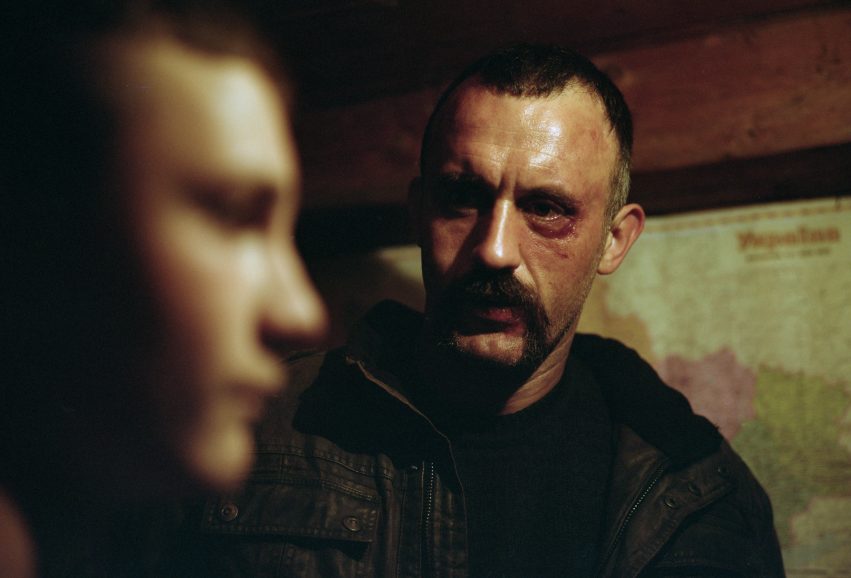

You’ve done a lot of work as an operator – do you still like to operate as a DP, and why/why not?
Yes, I do like to operate myself nowadays; mainly because I very strongly feel the rhythm and composition I want to create with camera. I’ve had a lot of experience shooting dancers and choreography, that’s why operating means for me more than just following someone; it’s about being part of the movement. It means putting our own energy into the space where I am existing with the camera – to bring the camera’s own personality into the film.
For Pamfir it was very important, because we were looking for these magic takes (where it all comes together – performance/light/rhythm) and you never know when that’s going to happen, on the first take or on the last one. Also, it was so precise on composition and movement, that I think it was also easier for me and Dmytro just to be together in that conversation.
Let’s talk about lighting – what was your general approach to lighting Pamfir, and what was your collaboration like with the gaffer?
In general we were aiming to shoot Pamfir in a realistic lighting style. But also we had been looking into strong colour representation in this movie, so we tried to implement colours into lighting as well as production design. Our goal was to find a perfect balance of those elements while lighting scenes. Together with Dmytro and Ivan, we tried to find those practical light elements which would help us to get a natural colour expression on locations.
Creatively we were looking into East Asian movies and how interesting colour can be part of a real environment. I think my main inspiration for colour in Pamfir comes from movies from that region.
Also – because Pamfir has a Greek tragedy form – we thought that putting this movie in dark colours and tones would be a tautology; that was also one of the reasons why we went into using a strong colour palette.
Because of the very complex logistics of this movie, I had to keep all the lights I needed in one truck. So my kit was pretty optimal for all locations we shot.
Valeriy Butkov has gaffered all of my features and many of the commercial projects I have done in Ukraine, so he already knew what kind of units I like to use and my techniques, so I was safe in the knowledge that he could get anything we needed for this two-month trip. And it’s interesting because even on a random day in the middle of the shoot, you know the tools you have and you can find a way to light any scene, even with limited resources.
During tech scouting locations together we had a main plan for all the scenes and locations, but I usually asked him to let me make two priority decisions on the day of rehearsal when we set up final blocking. Usually, during first part of the day, we would rehearse /light /dress the set and then after lunch we would shoot first takes.
Kit-wise, I had a bit of everything (tungsten/HMI/LED/small LED) and also we bought some street lamps – four mercury vapour and four sodium vapour lamps, so we could use them to light night exterior backgrounds. We mainly decided to use original street lamps because the of the sodium and mercury vapour colours they gave. Yes, of course we could use any RGB LED, but at that point we thought original street lamps would give us greater realism for the environment.
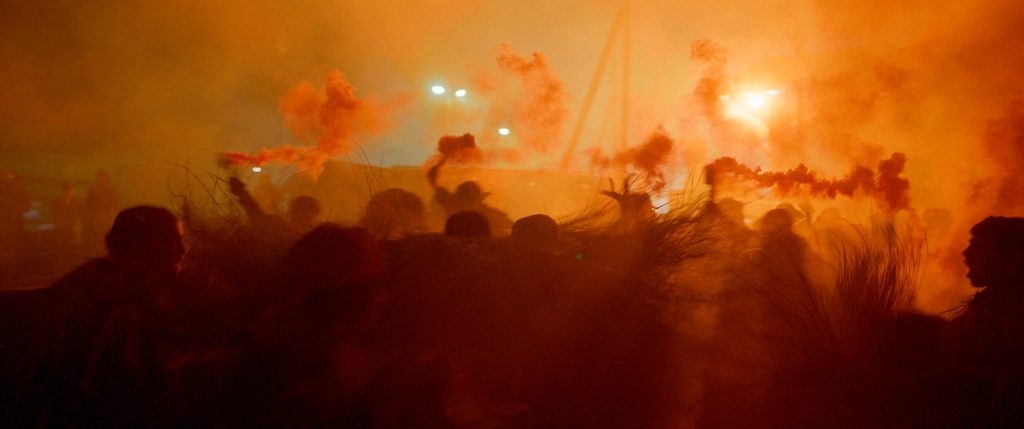
What was the most challenging location to light and why – can you talk us through it, including the kit you used?
I think the most challenging scene to light was a scene when Pamfir enters the boranka fight.
This was mainly because we needed to cover a large area and because of very complex blocking, we were looking 360 degrees around with the camera. Unfortunately for that scene we did not have any pre-light, so it was very important for us have a solid plan for lighting. Together with the director, gaffer and main character we did a couple of early rehearsals to see the distance we needed to cover and also where we could hide our lights.
Also, right before shooting this scene, the only Condor I had ended up breaking and my unit, which was supposed to be overhead ambient light, did not work. After I realised that there was no way it could be fixed quickly, I just left it on the ground and used it a strong backlight source when Pamfir was walking to the boranka. That was a happy accident on the day which works very well in the final result.
Because I was using a lot of colour in that scene, it was very important to make quick and efficient decisions of colour balance before we started shooting this large scene, which involved many extras and fighting. When we did the first big rehearsal with all the extras and lighting, we did a few tweaks on colours and intensity, and then we were ready to shoot a first take. But I think the most challenging aspect in that scene was time and scale.
Who was the colourist and what was their brief for the grade?
We worked with Anna Sujka, an amazing colourist from Poland, and spent four weeks in Warsaw together with her and Dmytro colouring this film.
During principal photography I was using my production LUTs which included the contrast we liked, and then we did a little correction in that for the main colours we used, like green and orange. That was enough for me to light this movie in the way I wanted it. That gave us pretty good base for dailies and on set monitoring.
When we got into the grade, we had a great base in our original negative, so together with Anna we were trying to elevate our colours to the next level and find the right tone of the colours we liked, and balance all the movie to get a strong look – but not too oversaturated, still realistic but not too washed out.
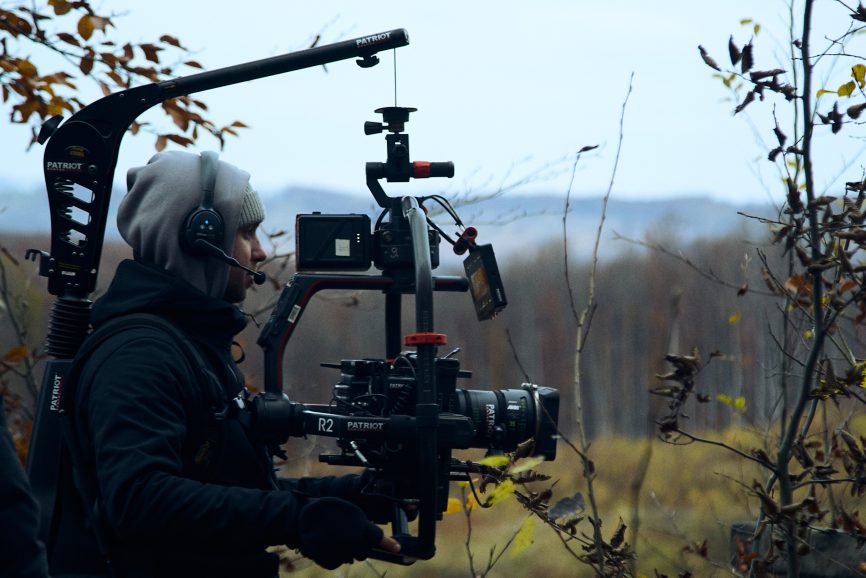
What are you most proud of from your work on Pamfir?
Pamfir taught me a lot, and I am proud of the fact that together with a great team of collaborators we have been able to create a movie which truly reflects the characters’ souls and emotions on screen. Any technical aspect can never be compared to this emotional impact that a movie can have, and I am very proud that Pamfir does that (at least for me).
What would be your dream future project as a cinematographer?
My biggest dream right now is that Ukraine wins this war.
My dream future project is to continue working on Ukrainian movies and develop Ukrainian contemporary cinema about my country and my people.
During the Russian full-scale invasion of Ukraine, we have lost two Pamfir teammates – Olexandr Syvorov (pyrotechnic stunts/effects) and Volodymyr Chornuy (set dresser). They had been fighting in the Ukrainian armed forces since the beginning of this war. A lot of talented Ukrainian filmmakers are fighting with bravery for Ukrainian freedom at the moment, and lots of them have already given their lives for this freedom.
My biggest dream is that all Ukrainian soldiers safely return back home and the Ukrainian nation can continue blooming and show the world our talent in all industries!
Pamfir is now available to watch at home: www.conic.film/films/pamfir

